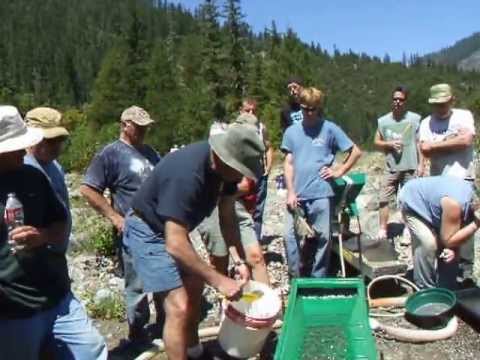Highbanking: Finding Gold with Placer Mining

Over a period of years, I’ve had the opportunity to use all the major brands of highbanking units now being marketed, and I enjoy this form of placer mining. There’s something very satisfying about getting out there with a shovel, right smack in the middle of Mother Nature, working in the sun with the sound of the water nearby. When the signs of gold start showing up in the sluice, I have a real hands-on feeling of satisfaction about what I’ve accomplished.
When the opportunity came up to work with field testing the new deluxe highbanking unit, I was intrigued and jumped at the chance. This outing, however, was not open to the public–we were field testing a new component for this unit-their new in-line jetting system.

As I helped set up the unit, my first impression was that it was very nice looking! Bright green hopper, and a really tough baked-on paint coating on all the wear parts to match–they call it “powder-puff,” some type of coating to extend the life of the metal. Then, I was pleasantly surprised by all the conveniences built into the unit. They have levels going two directions to help adjust the sluice box level from side-to-side and right to an inch per foot gradient for good gold recovery. This makes it easy and fast to get the unit set up properly–even on uneven ground. The unit has a gold scalper built right into the hopper and a removable grizzly screen above it. I made an adjustment to the spray bars so we wouldn’t get sprayed in the face–hey, I thought this was a great feature, because I wear glasses and usually spend most of my time highbanking, blind from the water on my glasses, not to mention having my clothing soaked.
I was really intrigued by the very different-looking riffle system in their sluice.
I went down to the water’s edge to set up the engine and pump. That new P330 pump they have is really nice looking, and I could tell it had been machined very well. Pro-Mack has a new priming system, and it’s not only very simple, you don’t have to huff and puff! A priming pump comes with the unit and has a clear hose that screws onto a fitting on the Pro-Mack pump. This priming pump sucks on both the up and down stroke, so all you have to do is pump a few times until you see water in he clear hose and shut the valve off. You’re all primed!
Back at the unit, I connected the layflat hose to the front of the hopper assembly and was looking the area over. We were ready to start. He showed me how the bar that lifts to support the hopper has adjustments, and commented that he’d adjusted it high, since we were going to do some testing first, so I could see how the scalper worked.
We took a few shovels from a promising area, put them in a bucket, and dumped them into the hopper. The spray bars efficiently washed the material (without spraying me!), and the larger leaned rocks, etc., rolled out the back of the hopper as the washed material fell through the grizzly. Actually, the hopper is designed so well that the water spray helps shove the oversized material over the grizzly and out. I was impressed! Then, this is where this unit really differed from any I’ve used before! With a valve in front of the hopper, they lowered the flow of water, opened another valve to direct the flow out a short garden hose, and the hopper was now dry without anyone having to go down to the water and shut off the engine. I lifted the grizzly screen out at their instruction, and six inches or so below it was a small screen over a square of miner’s moss carpet. This was the sampling scalper I’d heard about. Loosening a wing nut underneath, I raised the screen, filled a gold pan with water from the garden hose, and lifted the carpet out to wash it. After dropping it back in and replacing the screen, I quickly panned the small amount of concentrate, and was surprised by the gold in my pan. Bill chuckled at the amount, however and told me to pick the next spot–he said we could do better.
I picked another area, under some likely looking boulders piled on the bank, and we took some material again and repeated the process. This showing was even better. We were about 20 yards from he unit, and I assumed we’d carry buckets that far, but Dave just lifted the hopper a little with one hand, laid the support bar down and dropped the hopper to the sluice, then piled buckets and shovels on top and away we went after unscrewing the layflat hose. One trip and we were set up very near where we were shoveling. This was handy, as someone had failed to fill in a hole (a no-no), and we were going to use this as a settling pond and fill it in with our tailings.
Made an adjustment to the hopper again, reconnected the hose, turned the water back up and we were off. I asked them to do the shoveling for a while. I wanted to spend some time watching the water flow through the sluice and see what I thought of it. As I watched, I could see that there was a classifier under the hopper, then a section of Hungarian riffles. About halfway down, he Hungarian riffles ended, and there was a different riffle configuration they call “Armor Weave,” with expanded metal rising up from the last Hungarian riffle, and covering over the top of the Armor Weave. I watched the water action and waited for rocks to build up–this didn’t happen. I could see that the water which passed through the expanded metal was slowed…that was good, better for dropping fine gold. I also noticed it effectively classified all the material as soon as it reached that point. I noticed that the Pro-Mack pump really put out the water–according to them a full 330 gallons per minute–that’s amazing for a pump on a 5.5hp Honda engine!
Well, at this point, I gave up analyzing, and jumped into shoveling along with the other two, and we spent an hour or so at it. We also took turns in panning some of the tailings coming off the end of the slice to check whether the sluice was losing gold. none of us found a single speck–a very good sign. I didn’t want to take up too much of their time with this type of testing, however. I knew they were anxious to test the in-line jet. I did remember to look at the Armor-Weave to see if it was loaded up with gravel when they shut off the engine, and I was surprised to see that it appeared to be concentrating perfectly. The final test would be how fine the gold was in the concentrate, however.
I cleaned the sluice and carpet, using the on-board garden hose again to help with this, and then we panned out the concentrate. Some of the gold was super fine! When we were through I was very pleased, but I knew I’d feel better with another test done on my own.
After reassembling the sluice, I added the suction hose to the back of the hopper, and removed the layflat from the front of the hopper, connecting it to their new in-line jet. The suction hose had a tip at the other end which was immersed along the river’s edge, and they tested this new jet against the normal suction nozzle. I was surprised to find that there was a significant increase in suction using the in-line jet. In fact, they had plenty of suction power just running the engine at half-throttle! Also, using the suction tip is much lighter than having to handle the heavier nozzle jet of a normal highbanker–most welcome at the end of a long day, no matter how good the gold is.
I loaded it up, promising to have it back within a week, and took it home. I planned to take it out the next day to one of my favorite spots. Two friends dropped by that evening and asked what I had in the back of my truck. When I explained, they insisted on coming with me, intrigued by what I had told them about the new unit. One of them had what I consider to be the most popular of the conventional highbankers, and he was going to bring it along. We made arrangements to leave early the next morning so we’d have plenty of time.
When we arrived, we set the units up side by side. We shoveled from the same hole, did every kind of comparison test we could think of, and I mean to tell you, we were all very impressed with this new unit! The difference in the recovery rate of the two units was remarkable. The difference in pump power (much more versatile) was very apparent, and there was no doubt in our minds that his new unit was far superior to others.
SUMMARY — The Deluxe Highbanker – 3″ Dredge Combo is a major improvement over the other conventional highbankers I’ve seen in the field. It has a more powerful pump–so you can work further from the water source–or simply turn the motor down to save gas. It has a much improved, quick and easy priming system that other systems don’t have. It has special levelers attached to make proper sluice box setup a breeze–especially for beginners. It has an improved hopper design which keeps water from spraying in your face–and adjustable water bars. It has a special sampling scalper–so you don’t have to go to the trouble of cleaning up the entire sluice box every time you do a new test. It has a new in-line jet which powers the dredge portion of the highbanker. This increases suction power and makes the nozzle lighter and easier to manage. None of the other highbankers available have these features. And, it has the best gold recovery I’ve ever experienced in sluicing. All this, and it also looks good! Well done, Pro-Mack; highbanking will never be the same again! To see or purchase one of these units, call 916-493-2013 and ask for more information.

